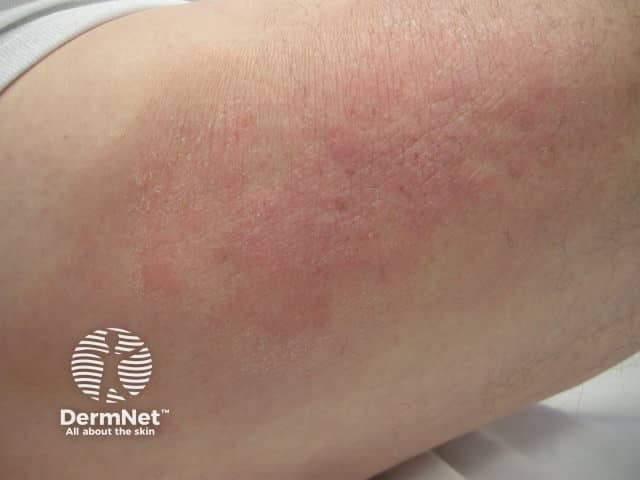Main menu
Common skin conditions

NEWS
Join DermNet PRO
Read more
Quick links
Author: Hon A/Prof Amanda Oakley, Dermatologist, Hamilton, New Zealand, December 2016.
Introduction Causes Clinical features Investigations Treatment
Meralgia paraesthetica (US spelling, paresthetica) describes a localised form of cutaneous dysaesthesia in which there is pain and a changed sensation in the skin on the lateral aspect of the thigh.
Meralgia means pain in the thigh, and paraesthetica refers to burning pain, tingling or itch. Some patients describe itch in the affected area. Meralgia paraesthetica is also called lateral femoral nerve entrapment syndrome.
The patient often complains of intense itch but no rash; however, scratching and rubbing can cause bruises and thickened skin.

Meralgia paraesthetica
Meralgia paraesthetica is due to compression or traction of the lateral femoral cutaneous nerve in its pathway from the lumbar plexus, L2-3. This most often occurs under the inguinal ligament and may be precipitated by:
Meralgia paraesthetica is characterised by tingling, numbness, burning pain or rarely, intense itch (pruritus) on the outside of the thigh. In about one in five people, it can affect both sides. Symptoms can be intermittent or continuous. They tend to be made worse by standing and walking and relieved by sitting. When itchy, the itch is unrelieved by scratching, although the scratching and rubbing may be pleasurable.
In many patients, there are no visible signs. If it is itchy, visible changes often arise from rubbing and scratching the affected area. These include:
There may be changed sensation in the affected area of skin, when this is tested for with pinprick, cotton wool or heat and cold, with either numbness or exaggerated sensations being reported. There may be reduced or absent sweating in the affected area.
The examination should include extending the thigh posteriorly, as symptoms may be reproduced by stretching the nerve. The pelvic compression test is usually positive (this involves deep palpation in the groin). There should be no signs of muscle weakness.
Radiology such as ultrasound imaging, X-ray, CT scan or MRI of the hip and pelvic area may be recommended. In many cases, no abnormality is revealed. Other tests may include electromyography (EMG) and nerve conduction study to identify damaged nerves. The diagnosis may be confirmed by relief of symptoms after an injection of local anaesthetic into the entrapment site.
Skin biopsy is rarely performed and may show reduced intraepidermal nerve fibre density.
Treatment of meralgia paraesthetica is not always necessary, as symptoms can settle on their own, and it is not always successful.
Physical therapy has been reported to be effective.